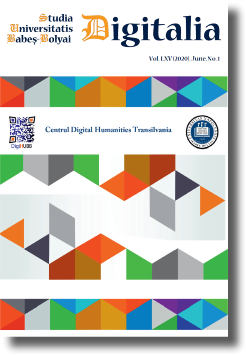The story of the first electronic computer in Hungary
DOI:
https://doi.org/10.24193/subbdigitalia.2017.2.02Keywords:
computing history, computers and education, Hungarian scholarsAbstract
After several preparatory activities in the early 50s, the Hungarian Academy of Sciences decided that it is necessary to have an electronic computer in Hungary. The Research Group for Cybernetics was established in mid-1956 and charged with the task of obtaining one. As commercial solutions proved to be impossible at that time it was decided to build the clone of a recently developed Soviet computer. The M-3 was a medium sized member of one of the first families of Soviet computers. Complete documentation and a package of key components were received in the framework of scientific cooperation. (Similar clones were built in Tallinn, Beijing, Erevan and M-3 was later manufactured in Minsk) Building of the M-3 started late 1957 (with the author's participation). Some life-signs were emerging in 1959, while more-or-less stabile operation was reached in 1960. Several improvements were made over the original design. Magnetic drum memory was exported to Timisoara for MECIPT. Despite its low performance, M-3 was successfully used to solve many real-life problems both for scientific-engineering calculations and in mathematical economics. Applications in other fields, like linguistics started too. The most important contribution of M-3 was its role in educating computer experts: many of the future leading personalities - both on the development and on the application side - got acquainted with computing around the M-3. M-3 served academic computing until 1965, extended with three more years at Szeged University. In the first part of the 60s commercial computers started to arrive to Hungary both from the USSR and the West.
References
[1] Tibor Szentiványi: A számítástechnika kezdetei Magyarországon [The beginnings of computing in Hungary], Természet Világa, 1994, No. 6, p. 5 (in Hungarian).
[2] Б.Н. Малиновский: История вычислителной техннки в лицах. Киев, 1995, ISBN 5-7707-6131-8 [English translation: Malinovsky, Boris Nikolaevich. Pioneers of Soviet Computing. Edited by Anne Fitzpatrick. Translated by Emmanuel Aronie, N.p.: published electronically, 2010]. http://www.sigcis.org/files/sigcismc2010_001.pdf
[3] Isaac Semenovich Bruk, One of the USSR most famous computer pioneers. Russian Virtual Computer Museum, Hall of fame. http://www.computer-museum.ru/english/galglory_en/Bruk.htm
[4] Bashir Iskanderovich Rameev. Russian Virtual Computer Museum, Hall of fame. http://www.computer-museum.ru/english/galglory_en/rameev.htm
[5] Automatic Digital Computer M-1. Russian Virtual Computer Museum. http://www.computer-museum.ru/english/m1.htm?sphrase_id=283246
[6] The Fast Universal Digital Computer M-2. Russian Virtual Computer Museum. http://www.computer-museum.ru/english/m2.htm
[7] The M-3 computer. Russian Virtual Computer Museum. http://www.computer-museum.ru/english/m3.htm
[8] Nikolay Yakovlevich Matyukhin. Russian Virtual Computer Museum, Hall of fame. http://www.computer-museum.ru/english/galglory_en/Matyukhin.htm
[9] Georgiy Pavlovich Lopato. Russian Virtual Computer Museum, Hall of fame. http://www.computer-museum.ru/english/galglory_en/Lopato.htm
[10] MTA KKCS. Memorial conference about the Research Group on Cybernetics, October 15, 2014. http://itf2.njszt.hu/itf_rendezvenyek/mta-kkcs
[11] Zsuzsa Szenrgyörgyi. A Short History of Computing in Hungary, Annals of the History of Computing, Vol. 21, No. 3, 1999. http://itf2.njszt.hu/324rtr4/uploads/HUNGAR1-11.pdf
[12] Bálint Dömölki. Computing in Hungary – Through the History of Five Institutions, in: Proceedings of the 8th IT STAR Workshop on History of Computing, pp. 80-93, IT STAR Publications, Volume 7, ISBN 978-88-98091-34-8. http://itf2.njszt.hu/objektum/computing-in-hungary-through-the-history-of-five-institutions
[13] The past of the future. IT History exhibition of the John von Neumann Computer Society. http://ajovomultja.hu/?language=en
[14] Győző Kovács. The short history of M-3, the first Hungarian Electronic Digital Tube Computer, IT STAR Newsletter, Vol. 6, 2014, No. 3, pp. 4-6. http://www.scholze-simmel.at/it_star/wp-content/uploads/nl_3_08.pdf
[15] Győző Kovács. 50 Years Ago We Constructed the First Hungarian Tube Computer, the M-3, IFIP Congress, Brisbane Australia 2010, IFIP AICT 325, pp. 68-79, New York: Springer, 2010, ISBN 978 3642 15 1.
[16] Máté Szabó. The M-3 in Budapest and Szeged (Scanning our Past). Proceedings of the IEEE, Volume 104, Issue 10, Oct. 2016, pp. 2062-2069. http://itf2.njszt.hu/324rtr4/uploads/The_M-3_in_Budapest_and_Szeged_preprint.pdf.
Downloads
Published
How to Cite
Issue
Section
License
Copyright (c) 2017 Studia Universitatis Babeș-Bolyai Digitalia

This work is licensed under a Creative Commons Attribution-NonCommercial-NoDerivatives 4.0 International License.


